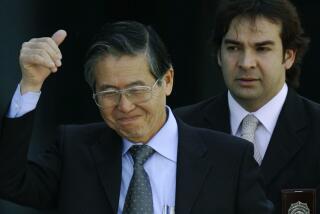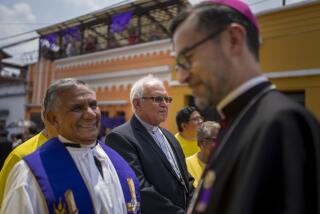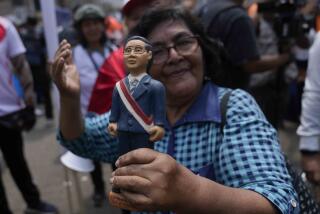Peru Cleric, Swiss Writer Shoulder Hostage Crisis
LIMA, Peru — In an almost-daily ritual, the two intermediaries trudge through the no man’s land of Thomas Alva Edison street here, past a phalanx of police commandos and television cameras into the mansion where terrorists are holding 74 hostages.
Later, the two men emerge from the Japanese diplomatic compound, sometimes empty-handed, sometimes carrying a list of hostages to be released. Their pace is heavy, as if weighed down by the attention and suspense that follow them.
These intermediaries in the 3-week-old Lima hostage standoff are an intriguing duo of peacemakers:
* Michel Minnig, chief of the International Committee of the Red Cross in Peru, is a globe-trotting Swiss political scientist and writer, a steadfastly neutral humanitarian.
* Bishop Juan Luis Cipriani is a provincial cleric known for his steely conservatism, a former basketball star and one of the few Peruvians whose counsel is sought by President Alberto Fujimori.
Together, Minnig and Cipriani carry the hopes for a peaceful resolution of the hostage crisis. They are both in the middle, but their tasks are distinct. And Cipriani’s role, in keeping with the secretive approach of the Peruvian government, remains vaguely defined.
As Minnig pointed out in a recent interview, the middle is an “awfully difficult” place. The lanky Red Cross chief, who has steady gray eyes and speaks English and Spanish with a gentle French accent, also said, “Everybody has his own interpretation of what the middle is.”
Minnig has spent 12 years as a Red Cross representative in places that are shorthand for savagery: Bosnia-Herzegovina, Lebanon, Rwanda, Burundi. He is 44, an academic and literary critic who took a year off to write a novel, as yet unpublished, about a Swiss man who leaves his Alpine village to explore the tragedies of the Third World.
“Minnig is a careful thinker,” a colleague said, describing how Minnig has pored over speeches about the crisis by Fujimori, looking for hints and nuances. “He likes to find good questions and answers. He’s not a man of quick answers, which I think is good.”
Three months after he was assigned to Peru, Minnig was among the foreign and Peruvian elite invited to the Dec. 17 reception at the Japanese ambassador’s residence. He was chatting about human rights when familiar sounds erupted--gunshots, explosions, screams. Instinctively, he dodged through the gun battle to the invading terrorists of the Tupac Amaru Revolutionary Movement, identified himself and began mediating with police outside. He has not stopped since.
Tupac accepted Minnig’s offer because the Red Cross does humanitarian work with Peruvian terrorists imprisoned in dungeon-like conditions that have been condemned by human rights advocates.
Minnig set up the rules and mechanics of the siege, ensuring the flow of food, medicine, clothes and letters from relatives, brokering the periodic hostage releases. His world had been turned upside down: Tupac was now the jailer; the police commanders, Cabinet ministers and other leaders were inmates. And, Minnig said, “the mansion looks more and more like a place of detention.”
*
Minnig dedicates himself to making the impromptu jail as civilized as possible. When rumors spread among terrorists and hostages that police were preparing a raid, he spent a night in the residence. He offered himself as a human shield “just to make sure there would be no misunderstanding on one part or the other.”
He shrugs off accolades. He says he is pleased mainly because of the improved image of the Red Cross, which some Peruvians regarded with distaste because of its aid to imprisoned terrorists.
Minnig’s rock-like composure cracked only in a frenetic incident last week in which photographers were allowed to approach the mansion, then ignored police orders and swarmed inside for an improvised news conference with Tupac terrorists. An indignant Minnig temporarily pulled out the Red Cross.
“It just hardened the situation,” he said, comparing the frenzied media coverage of the siege to a Latin American soap opera, or telenovela. “And like a telenovela, sometimes it is not serious at all. Images are not information.”
Minnig insists his role is limited. He said the government and terrorists must intensify their talks.
He politely declines to define the role of his fellow messenger, Bishop Cipriani of Ayacucho, who first appeared on the scene Christmas Day. Cipriani, 55, who has avoided talking to the press, said in brief public comments that he was doing only “pastoral work.”
Although Peru’s official negotiator is the education minister, the bishop is widely regarded as a government emissary. His friendship with Fujimori gives him unusual access to a president with a tiny circle of advisors and a penchant for secrecy. Fujimori flies several times a month to the mountain city of Ayacucho to lunch with the bishop and to sound him out on terrorism and other issues, diplomats say.
*
Fujimori knows a fellow tough guy when he sees one. Ayacucho was the cradle of the insurrection by Shining Path terrorists. Even in the worst bloodshed, Cipriani publicly defied the terrorists by refusing bodyguards and riding his bicycle through the streets. He acquired a reputation as a hard-line Fujimori defender against human rights advocates--and fellow priests--who accused security forces of abuses.
“In a context of violence like Ayacucho, deaths, disappearances and abuses are part of the war,” Cipriani told the magazine Caretas in 1994. “I think the armed forces had to use mechanisms . . . and naturally there were deaths on both sides.”
Cipriani followed an unorthodox career path. He starred on Peru’s national basketball team as a young man, studied engineering and entered the priesthood at the relatively advanced age of 33. He belongs to Opus Dei, a Roman Catholic order that has a right-wing ideology, a fundamentalist attitude on social issues and an eye for recruiting talented, influential people.
Although his politics seem the opposite of Tupac’s, Cipriani holds long talks with the terrorists and reportedly contributed to some hostage releases.
Neither Cipriani nor Minnig visited the scene Monday, suggesting the impasse has not broken. But in another sign that Cipriani has become a key, he met with the visiting Bolivian foreign minister Monday to discuss the condition of the Bolivian ambassador and the 73 other hostages for whom the faces of hope are a Peruvian bishop and a Swiss intellectual.
More to Read
Sign up for Essential California
The most important California stories and recommendations in your inbox every morning.
You may occasionally receive promotional content from the Los Angeles Times.










